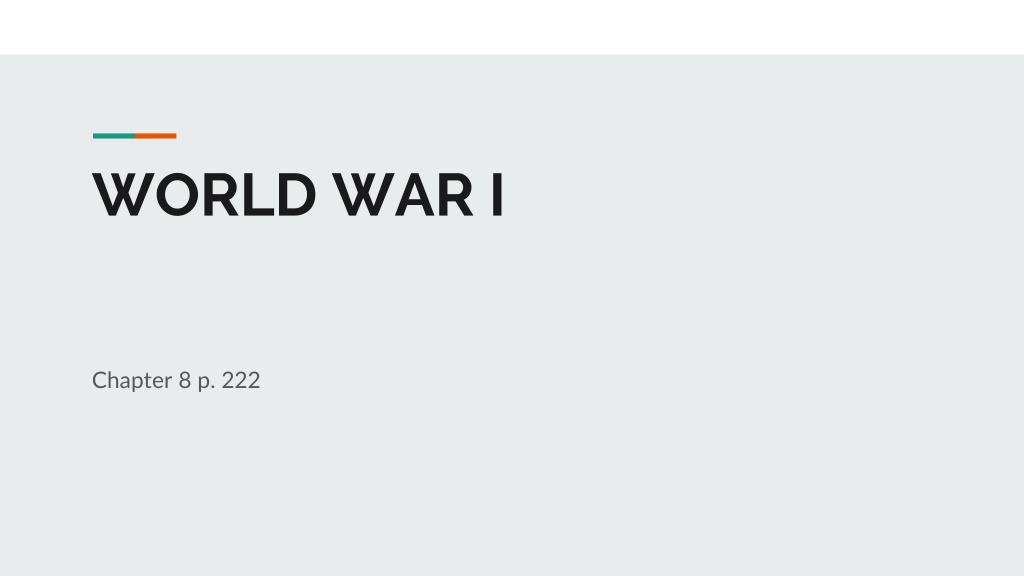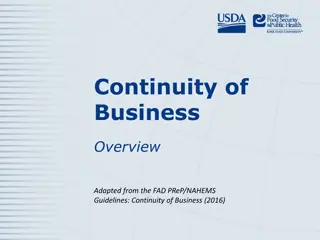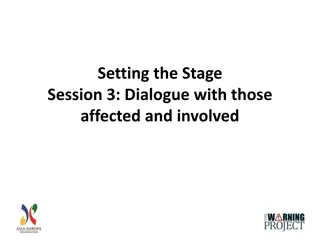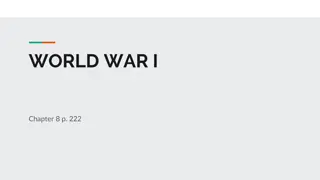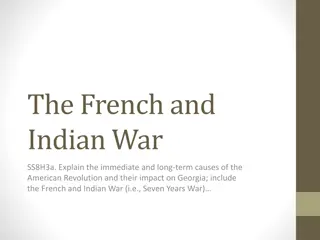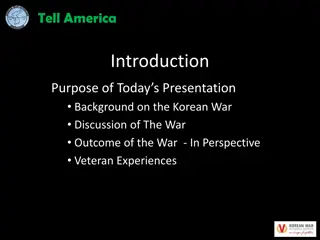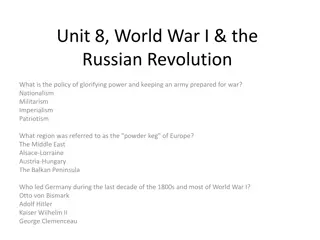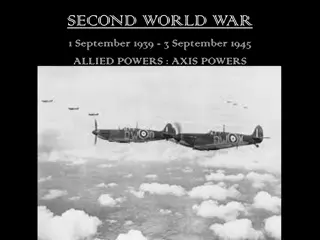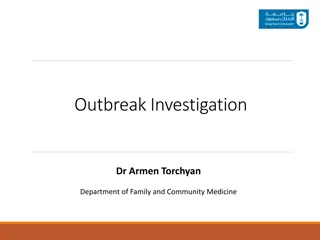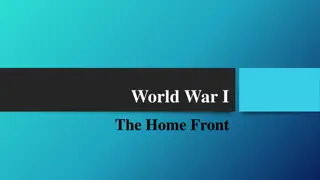Causes and Outbreak of World War I
Various factors such as nationalism, imperialism, militarism, and the assassination of Archduke Francis Ferdinand led to the outbreak of World War I. The tensions in Europe escalated as countries formed alliances and mobilized for war. The conflict resulted in early battles like the Battle of Marne and the use of trench warfare. The war saw a stalemate and the introduction of German U-boats in land and sea battles. Eventually, the United States entered the war due to crises with Germany.
Download Presentation

Please find below an Image/Link to download the presentation.
The content on the website is provided AS IS for your information and personal use only. It may not be sold, licensed, or shared on other websites without obtaining consent from the author.If you encounter any issues during the download, it is possible that the publisher has removed the file from their server.
You are allowed to download the files provided on this website for personal or commercial use, subject to the condition that they are used lawfully. All files are the property of their respective owners.
The content on the website is provided AS IS for your information and personal use only. It may not be sold, licensed, or shared on other websites without obtaining consent from the author.
E N D
Presentation Transcript
WORLD WAR I Chapter 8 p. 222
8.1 The Road to War Main Ideas: Many factors contributed to the outbreak of WWI. European nations suffered massive casualties in the war s early battles. Key Terms & People: militarism, Archduke Francis Ferdinand, mobilize, Central Powers, Allied Powers, trench warfare, stalemate, U boats
Outbreak of War Nationalism (the strong sense of pride and loyalty to countries) caused many countries in Europe were tense and distrusting one another Austria-Hungary & Serbia threatened each others empire Imperialism was a fierce competition for gaining/taking territories- increased tension between countries Countries adopted militarism by increasing and strengthening their militaries As they became more powerful, they formed alliances (friendships/supporters)
The Spark Austria-Hungary heir to the throne, Archduke Francis Ferdinand was assassinated by a Serbian man which caused A-H to declare war on Serbia. Allies picked sides and mobilized (prepared) for war. Central Powers: Austris-Hungary, Germany, Ottoman Empire, Bulgaria Allied Powers: Serbia, France, Great Britain, Russia, Italy Eventually, 30 countries from 6 continents were fighting in the GREAT WAR (not called WWI yet)
Early Battles Battle of Marne- Germany was moving towards Paris, France but Belgian and French armies blocked the attack and Germany retreated If they would not have stopped the Germans here, France would have to surrender to Germany France and Germany fought up and down the eastern and western borders Soldiers typically fought using trench warfare-this was effective because they could defend their side from deep ditches that blocked attacks. The middle was referred to as no mans land
Land and Sea Battles After a year, there was a stalemate- neither side could beat the other side-no victorious battles The Germans responded by using submarines called Uboats. They launched torpedoes against Allied supply ships (not battle ships), causing heavy losses of supplies. Germany also sank boats that belonged to neutral countries.
8.2 America prepares for war Main Ideas: US entered the war after repeated crises with Germany. US mobilized for war by training troops & stepping up production of supplies. Labor shortages created new wartime opportunities for women and other Americans. Key Terms & People: Lusitania, Zimmermann Note, Selective Service Act, Liberty bonds, National War Labor Board
Neutrality Threatened US Pres Wilson announced that the US would remain neutral in this European conflict. Many immigrants sympathized with their homeland. US factories continued to trade with European nations and shipped supplies to the Allies. US invested in war bonds in Allied countries (gave money). Germans attacked ships with U boats to stop delivery. US warned them to stop but they eventually attacked the Lusitania, a British passenger ship killing Americans on board. Zimmermann Note was a secret telegram from Germany to Mexico-seeking an alliance. This note was published in US newspapers. US declared war to make the world safe for democracy .
US mobilizes for war Propaganda posters and pamphlets (p. 235) * 4 minute men gave speeches in theatres & churches Espionage Act (still today) and Sedition Act restricted free speech & jailed those against purpose Antiwar mail prohibited and seized *Liberty bonds provided money to Allies Selective Service Act drafted men 21-30 *African American men were also drafted Built and fueled ships and airplanes * Fed soldiers so farmers increased production Meatless Mondays and Wheatless Wednesdays to conserve meat and grains Victory gardens were planted so citizens were dependent on farmers Women drove ambulances and nursed the wounded to support the men
Wartime Opportunities Labor shortage in US due to 1) factories worked around the clock 2) immigration stopped during war 3) most men were in Europe fighting Women and immigrants had new opportunities and joined the workforce. Nurses, ambulance drivers, telephone operators, signalers, typists, and interpreters were popular jobs in Europe. Many worked in factories in the US and demanded equal pay and fair working hours through their labor union. National War Board helped workers and bosses arrange agreements so that work continued. Women like Jane Addams and Jeannette Rankin protested against the war.
How was Alabama used in WWI? P. 237 Training Camps were scattered around Al: Maxwell Air Force Base was then called Taylor Field - this is where pilots were trained. WWI was the first war that used airplanes. Camp McClellan in Anniston and Camp Sheridan near Montgomery also trained soldiers. Wilson Dam on Tennessee River built to provide electricity in Muscle Shoals plant that created explosives. Mobile Shipbuilding Company was created to build ships because the Gulf of Mexico port was safer than the Atlantic or Pacific ports (Germans were less likely to come into Gulf).
8.3 Americans in WWI Main Ideas: US soldiers started to arrive in Europe in 1917. US helped the Allies win the war. Germany agreed to an armistice after suffering heavy losses. Key Terms & People: American Expeditionary Force, communists, armistice
American Soldiers Arrive Allies were near defeat-Germany closing in on Paris again, pushing towards Russia, and sinking Allied ships. The result looked grim. American Expeditionary Force, led by General John Pershing arrived with 3 months intense training. Instead of mingling with Allied forces, Pershing kept Americans as one unit. Before joining the Allied, a group of Russians, called Bolsheviks overthrew Russian govt. They were communist and favored equal distribution of wealth and elimination of private property. Their leader, Vladimir Lenin signed Brest-Litovsk Treaty with Central Powers which decreased strength of Allied team. Russia left the war.
The American Soldier in WWI US arrived for the final battles. They lived in trenches with rats, lice and dead soldiers. They ate dried beef, hard biscuits, and canned rations. They wore wool uniforms and carried a blanket. The appearance of their rifles were designed to fool Germans into thinking they had machine guns. They carried a gas masks around their necks. Their backpack, called a haversack carried everything they needed for survival. P. 235
Winning the War As Germans attacked again on the Marne River, they were unprepared for the fresh energy and skills of US soldiers. US drove Germans away from Paris, France (major turning point)Allies defeated Germany in major towns, rivers, and forests. Harlem Hellfighters, African American group spent more time fighting than any other group. Awarded medals for bravery. US Navy strategy at sea-convoy system- protected their ships from Uboats 1918-enemy lines were broken for the first time-defeat was eminent
Armistice Armistice is a truce-agreement to stop fighting - signed Nov 11, 1918 at 11:00 (Veteran s Day today) German soldiers and citizens were starving and tired of fighting. Bulgaria and Ottoman Empire withdrew their support. One-fourth of German soldiers were captured (POW) by Allies. German leader, Kaiser Wilhelm gave up and fled to the Netherlands Germans were required to withdraw soldiers and destroy all war materials.
8.4 Establishing Peace Main Ideas: The costs of war included millions of human lives as well as financial burdens. Pres. Wilson and European leaders met to work out a peace agreement. US Senate rejected the Treaty of Versaileles. Key Terms & People: League of Nations, reparations, Treaty of Versailles, Henry Cabot Lodge
Costs of War Death: 5M Allied soldiers, 3.5M Central soldiers, 116K US soldiers-Germany and Russia lost the most; US lost the least-8.5M + died Wounded: 20M soldiers Money: Allies spent $145B, Central spent $63B, many European countries had borrowed money and now were in debt, citizens starving Infrastructure: Buildings destroyed, fields not fit for farming, $30B property destroyed
Was the flu worse than war? Worldwide epidemic of flu in 1918-contagious and deadly For 2 years, it killed about 30M people (800,000 Americans)- more than the long war Started in Army training camp in Kansas-spread quickly through the air unknowlingly Govt quarantined people due to no cure
Peace Agreement Pres Wilson s Fourteen Points: list of specific proposals for postwar peace Settled national border disputes, called for military cutbacks, proposed lower tariffs, banned secret agreements between nations Created League of Nations - mission was for all countries involved to settle disputes and encourage democracy Chart p. 245
Treaty of Versailles (France) Leaders of US, Britain, France, and Italy attended. Germany & Russia were not present. Most leaders blamed Germany and expected they pay $33B for war damages - reparations Pres Wilson reluctantly agreed to peace settlement Analyze border changes on map p. 246-
Versailles Treaty Rejected? All US treaties must be ratified by Congress with a majority rule ( ) Republican Senator Henry Cabot Lodge urged Congress not to vote yes on the treaty because he feared the US troops could be sent to war in the future by League of Nations instead of by Congress He and many other Congressmen wanted to limit US military commitments The majority voted no and the US never joined the League of Nations Instead they chose to practice isolationism and take care of themselves Chart p. 247
WWI Test Time Complete, check and study review p. 249-250 Summarize main ideas Know key terms and people Practice Quizlet Make A s! :)
